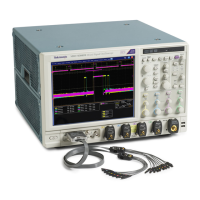Commands Listed in Alphabetical Order
Arguments
STAYSHigh indi
cates that a pulse edge must stay high (positive) for the required
time period to permit time out triggering to occur. This is the default polarity.
STAYSLow indi
cates that a pulse edge must stay low (negative) for the required
time period to permit time out triggering to occur.
EITher indi
cates that the polarity of the time out trigger can stay either high
or low (positive or negative) for the required time period to permit time out
triggering to occur.
Examples
TRIGGER:A:PULSE:TIMEOUT:P OLARITY:CH1 STAYSHIGH sets the polarity of
the A pulse time out trigger to positive for Channel 1.
TRIGGER:A:PULSE:TIMEOUT:P OLARITY:CH1? might return
:TRIGGER:A:PULSE:TIMEOUT: POLARITY:CH1 EITHER, indicating that the
polarity of the A pulse time out trigger for Channel 1 can be either positive
or negative.
TRIGger:{A|B}:PULse:TIMEOut:QUAlify
Th
is command sets or queries the Timeout Trigger qualification.
This is equivalent to selecting Timeout Setup from the Trig menu and selecting
O
ccurs or Logic in the Trigger if Timeout drop-down list box.
NOTE. If you use the LOGIc argument, you must specify the channel logic
conditions.
Group
Trigger
Syntax
TRIGger:{A|B}:PULse:TIMEO ut:QUAlify {OCCurs|LOGIc}
TRIGger:{A|B}:PULse:TIMEO ut:QUAlify?
Arguments
OCCurs specifies a trigger if any detectable event occurs.
LOGIc specifies a trigger if the individual channel qualifications meet the logic
patterns and thresholds set by the TRIGger:{A|B}:LOGIC:INPUT:C<x> and
TRIGGER:{A|B}:LOGIC:THRESHOLD:CH<x> commands.
Examples
TRIGGER:A:PULSE:TIMEOUT:Q UALIFY OCCURS sets the trigger qualifier to
OCCURS, w hich initiates a trigger if the instrument detects any timeout trigger
qualifications.
2-534 DPO7000, DPO70000/B and DSA7000/B Series Programmer Manual

